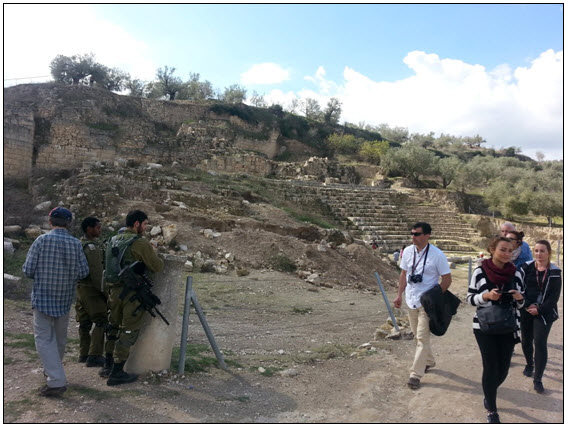According to the NGO “Emek Shaveh,” Tel Sebastia, located northwest of the city of Nablus in the direction of Jenin, might be the next archaeological site in the West Bank to be exploited by the settlers in their strategic struggle to take over the Occupied Palestinian Territories (OPT). The mound of Sebastia is identified with the city of Samaria, the capital of the Kingdom of Israel in the 9-8 centuries BCE, which continued to serve as an important city during the Roman and Byzantine periods when it reached its peak. Archaeologists from Ariel University, located further to the south in the OPT, have declared their intentions to renew excavations of the site.

Soldiers and tourists at Tel Sebastia, adjacent to the Palestinian village of Sebastia near Nablus (Photo: Emek Shaveh)
The historical site is in the Palestinian village of Sebastia and the land encompassed by the mound belongs to Palestinian residents of the village. For over a decade, during and following the Second Intifada, there has been almost no activity or presence of Israeli bodies at the site. However, for two years now the place has become the focus of renewed interest for settlers and the Civil Administration. There has been a sharp increase in the number of Jewish visitors on a weekly basis and sometimes the same groups visit more than once a week. This requires coordination with and support of the occupation forces. While the archaeological mound is in Area C, controlled in full by Israel, the residences of the villagers and the visitors’ parking lot are located in Area B where, according to the Oslo Accords, Israel retains responsibility for security.
In 1970 the site was declared as a national park named “Shomron” (Samaria) but for many years development of the park was meager. However, now the Israeli Nature and Parks Authority is once again heavily investing in the preservation of the site and entrance to it will shortly require paying an entrance fee.
The settlers emphasize that the site is the capital of the ancient Kingdom of Israel. The transformation of Sebastia into a tourism hub is clearly intended to strengthen the connection of Israel to this location, while undermining the Palestinian heritage and narrative in an effort to physically take over the land. For the settlers, the struggle for Sebastia is central to strengthening the Israeli presence in the West Bank and to the realizing the aim of re-establishing the settlement of Homesh, evacuated by Israel in 2005 at the same time that Israel uprooted its settlements in the Gaza strip.
Related:
http://alt-arch.org/en/the-political-struggle-over-the-future-of-tel-sebastia/


